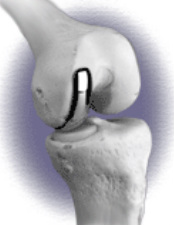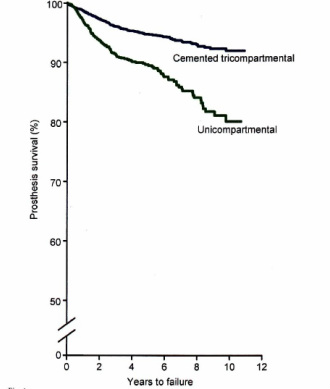Partial Knee Replacement
|
What is a partial knee replacement?
Surgeons describe the knee as having three compartments (medial, lateral, and patello-femoral). When a person has worn out the cartilage in only one of the three compartments, they may be a candidate for a partial knee replacement. Partial knee replacements are also called unicompartmental replacements or simply unis (see Figure 1). Who can have a partial knee replacement? Only about 10% to 15% of patients meet criteria for a partial knee replacement. Factors that the surgeon looks at to decide if a patient is a candidate for a unicompartmental replacement include:
|
Figure 1. Partial Knee Replacement
|
|
What are the benefits of having a partial knee replacement over having a total knee replacement?
The benefit is that a partial knee replacement can be done through a small incision and the recovery is quicker and less painful than a total knee replacement. After full recovery, it is debatable whether or not partial knees function or feel any better than total knees. What are the down-sides of having a partial knee replacement? First, only a small number of patients are even a candidate for a partial knee replacement, as noted above. For those patients who are good candidates, they should consider the fact that partial knee replacements usually do not last as long as total knee replacements. Please see Figure 2 which was taken from a study in Norway that compared 2288 partial knee replacements to 3032 total knee replacements. The study clearly shows that partial knee replacements (unicompartmental) do not last as long as total knee replacements (tricompartmental). |
Figure 2. Prosthesis Survival: Partial vs. Total Knee Replacement
Kaplan-Meier survival curves for cemented tricompartmental total knee replacements and cemented unicompartmental knee replacements
|




